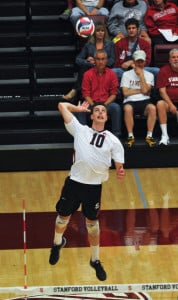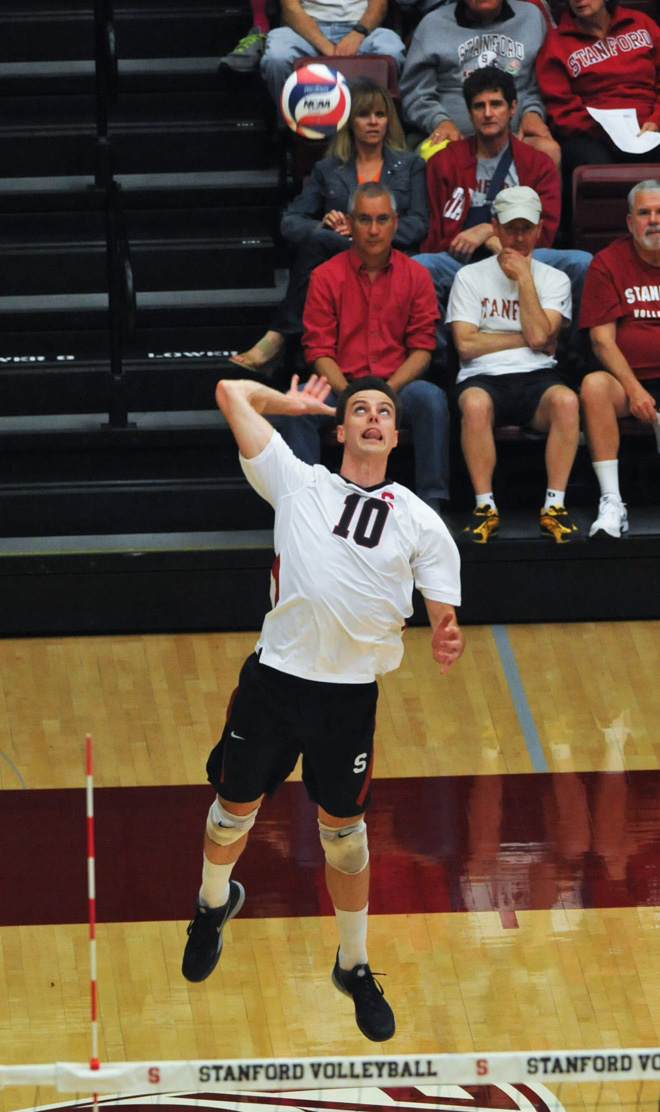The Stanford men’s volleyball team took a very unusual path towards a tremendously successful season, starting and ending the season ranked in the top five nationally and making it to the MPSF and NCAA Championship matches. The Cardinal (24-8, 17-7) ended the season No. 2 in the nation after a heartbreaking loss in the NCAA finals against No. 1 Loyola-Chicago, narrowly missing out on the program’s third national title.
But while Stanford ended the season with the strength and confidence that only a national contender could have, things did not always seem so bright for the team. Despite being ranked in the preseason top five, the Cardinal struggled early in the season to find a rhythm. The team seemed lost on the road, lacking confidence and getting frustrated when things weren’t going their way. They were unable to win five-setters, losing many close matches in gut-wrenching fashion. Consequently, the team lost three road matches in a row in the middle of January and began their once-hopeful season with a rocky 6-7 start in MPSF play.

But in true Cardinal character, Stanford showed maturity and resilience from that point forward. After returning to Maples with that 6-7 conference record, Stanford regained some of its confidence with two impressive wins. The team began to look unified, and the seniors demonstrated quality leadership by rallying the unit and keeping their poise in tough moments. Patience and a steady offense quickly began to define the team. Senior All-American Brian Cook led the team in kills 24 times this season, ending his all-conference season with 461 kills and averaging 3.81 kills per set.
Fellow senior All-American Steven Irvin also had an impressive season, coming through with critical plays and providing a sense of calm on the court. All the seniors were essential in keeping the team together; their experience with the program helped the team remain true to the Stanford style of play — smart offense and tough defense.
While the seniors provided the leadership the team needed throughout the season to get to the NCAA finals, the younger members of the squad demonstrated incredible growth and improvement on the road to the championships. Sophomore James Shaw controlled the offense throughout the season, pushing the offense to a .336 hitting average on the year. Shaw was recently named to the 2014 U.S. Men’s National Team for the World League competition.
Once Stanford found its groove as a team, the Cardinal seemed unstoppable. John Kosty’s group became the team to beat in March, but seemingly couldn’t find an answer to one team, the leaders of the MPSF conference — the BYU Cougars. After losing to BYU both at home and on the road earlier in the season, Stanford had a tough loss to the Cougars while playing the MPSF Tournament Championship match on BYU’s home court in Provo, Utah.
So when it came time to face BYU again in the semifinals of the NCAA Tournament, the two teams had built up a strong rivalry and both seemed equally eager to best the other. In what was in many ways its strongest show of talent, and more importantly teamwork and perseverance, Stanford finally overcame BYU and beat the Cougars in a nail-biting five set match.
With the win, Stanford found itself in familiar territory — playing for the program’s third national title. Stanford faced No. 1 Loyola-Chicago, which had home-court advantage and only one loss during the campaign. While Stanford played an impressive match and pushed the match to five sets, Loyola-Chicago used its home court advantage to gain momentum and win a national championship.
Overall, while the Cardinal’s season ended with a disappointing loss, it was the journey to the NCAA finals that truly mattered. And the end result of that journey was just as impressive as any national title because of the way the team overcame tremendous adversity, earning its No. 2 ranking through teamwork, tough work and patience. The Cardinal did not give up and rallied around each other and their coaches, with different players stepping up throughout the season. It was, again, a season of true Stanford volleyball.
Contact Eliza Thomspon at elizat ‘at’ stanford.edu.
